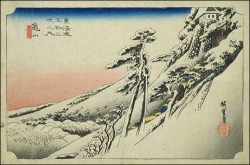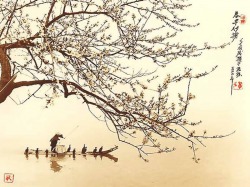Themes of Japanese Art Forms

The picture (left) is a Japanese art form. There are a couple of popular themes often seen in Japanese art forms.
"Japanese art prints, or Ukiyo-e (which literally means “pictures of the floating world”) have become an increasingly popular art form in the Western world. Their upward, floating imagery sprang from the Buddhist ideology that joy is transient and that only detachment from desire will bring true enlightenment" (www.emptyeasel.com/.../uploads/2008/04/hiroshige.jpg).
The beauty of nature and simplicity are two common themes in drama and literature. These were seen in Japan's art forms. Paper, ink, and brushes were used to show beauty, just like in China. This art of fine, intricate writing is called calligraphy, where there is a brushstroke order for each character. Shape and size affects a character's meaning. This technique was used on paper scrolls and silk, beginning in the 600s. Typical designs were intricately painted landscapes, past events, and everyday life, sometimes with written explanations.
Another traditional art was flower arranging, brought to Japan by Buddhists. They tried to show simple and natural beauty.
Small trees called Bonsais and shrubs in small pots or trays were grown. Landscape gardeners also tried to make the beauty of nature. Zen gardens with rocks, pathways, and small flowers were created to help quiet thinking. Gardening and flower arranging are both important today.
"Japanese art prints, or Ukiyo-e (which literally means “pictures of the floating world”) have become an increasingly popular art form in the Western world. Their upward, floating imagery sprang from the Buddhist ideology that joy is transient and that only detachment from desire will bring true enlightenment" (www.emptyeasel.com/.../uploads/2008/04/hiroshige.jpg).
The beauty of nature and simplicity are two common themes in drama and literature. These were seen in Japan's art forms. Paper, ink, and brushes were used to show beauty, just like in China. This art of fine, intricate writing is called calligraphy, where there is a brushstroke order for each character. Shape and size affects a character's meaning. This technique was used on paper scrolls and silk, beginning in the 600s. Typical designs were intricately painted landscapes, past events, and everyday life, sometimes with written explanations.
Another traditional art was flower arranging, brought to Japan by Buddhists. They tried to show simple and natural beauty.
Small trees called Bonsais and shrubs in small pots or trays were grown. Landscape gardeners also tried to make the beauty of nature. Zen gardens with rocks, pathways, and small flowers were created to help quiet thinking. Gardening and flower arranging are both important today.
Impact
You can see the impact in Chinese life as described above. In general, some effects include nature landscapes by gardeners, Zen gardens for thought, and the popular art of flower arranging.
Japanese Calligraphy- Eternal
永
永


